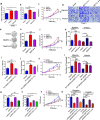CLK1/SRSF5 pathway induces aberrant exon skipping of METTL14 and Cyclin L2 and promotes growth and metastasis of pancreatic cancer
- PMID: 33849617
- PMCID: PMC8045197
- DOI: 10.1186/s13045-021-01072-8
CLK1/SRSF5 pathway induces aberrant exon skipping of METTL14 and Cyclin L2 and promotes growth and metastasis of pancreatic cancer
Abstract
Background: Both aberrant alternative splicing and m6A methylation play complicated roles in the development of pancreatic cancer (PC), while the relationship between these two RNA modifications remains unclear.
Methods: RNA sequencing (RNA-seq) was performed using 15 pairs of pancreatic ductal adenocarcinoma (PDAC) tissues and corresponding normal tissues, and Cdc2-like kinases 1 (CLK1) was identified as a significantly upregulated alternative splicing related gene. Real-time quantitative PCR (qPCR) and western blotting were applied to determine the CLK1 levels. The prognostic value of CLK1 was elucidated by Immunohistochemistry (IHC) analyses in two independent PDAC cohorts. The functional characterizations and mechanistic insights of CLK1 in PDAC growth and metastasis were evaluated with PDAC cell lines and nude mice. SR-like splicing factors5250-Ser (SRSF5250-Ser) was identified as an important target phosphorylation site by phosphorylation mass spectrometry. Through transcriptome sequencing, Methyltransferase-like 14exon10 (METTL14exon10) and Cyclin L2exon6.3 skipping were identified as key alternative splicing events regulated by the CLK1-SRSF5 axis. RIP assays, RNA-pulldown and CLIP-qPCR were performed to confirm molecular interactions and the precise binding sites. The roles of the shift of METTL14exon 10 and Cyclin L2exon6.3 skipping were surveyed.
Results: CLK1 expression was significantly increased in PDAC tissues at both the mRNA and protein levels. High CLK1 expression was associated with poor prognosis. Elevated CLK1 expression promoted growth and metastasis of PC cells in vitro and in vivo. Mechanistically, CLK1 enhanced phosphorylation on SRSF5250-Ser, which inhibited METTL14exon10 skipping while promoted Cyclin L2exon6.3 skipping. In addition, aberrant METTL14exon 10 skipping enhanced the N6-methyladenosine modification level and metastasis, while aberrant Cyclin L2exon6.3 promoted proliferation of PDAC cells.
Conclusions: The CLK1/SRSF5 pathway induces aberrant exon skipping of METTL14 and Cyclin L2, which promotes growth and metastasis and regulates m6A methylation of PDAC cells. This study suggests the potential prognostic value and therapeutic targeting of this pathway in PDAC patients.
Keywords: Alternative splicing; CLK1; Cyclin L2; M6A Modification; METTL14; Pancreatic cancer; SRSF5.
Conflict of interest statement
Shi Chen, Can Yang, Zu-Wei Wang, Jian-Fei Hu contributed equally to this work and all should be considered as co-first author. Shi Chen, Yao-Dong Wang, Yi-Feng Tian, Bai-Yong Shen also contributed equally, and all should be considered as co corresponding author. The authors declare that they have no competing interests.
Figures









References
-
- Sano M, Takahashi R, Ijichi H, Ishigaki K, Yamada T, Miyabayashi K, et al. Blocking VCAM-1 inhibits pancreatic tumour progression and cancer-associated thrombosis/thromboembolism. Gut. 2020. - PubMed
Publication types
MeSH terms
Substances
LinkOut - more resources
Full Text Sources
Other Literature Sources
Medical
Molecular Biology Databases
Research Materials
Miscellaneous

